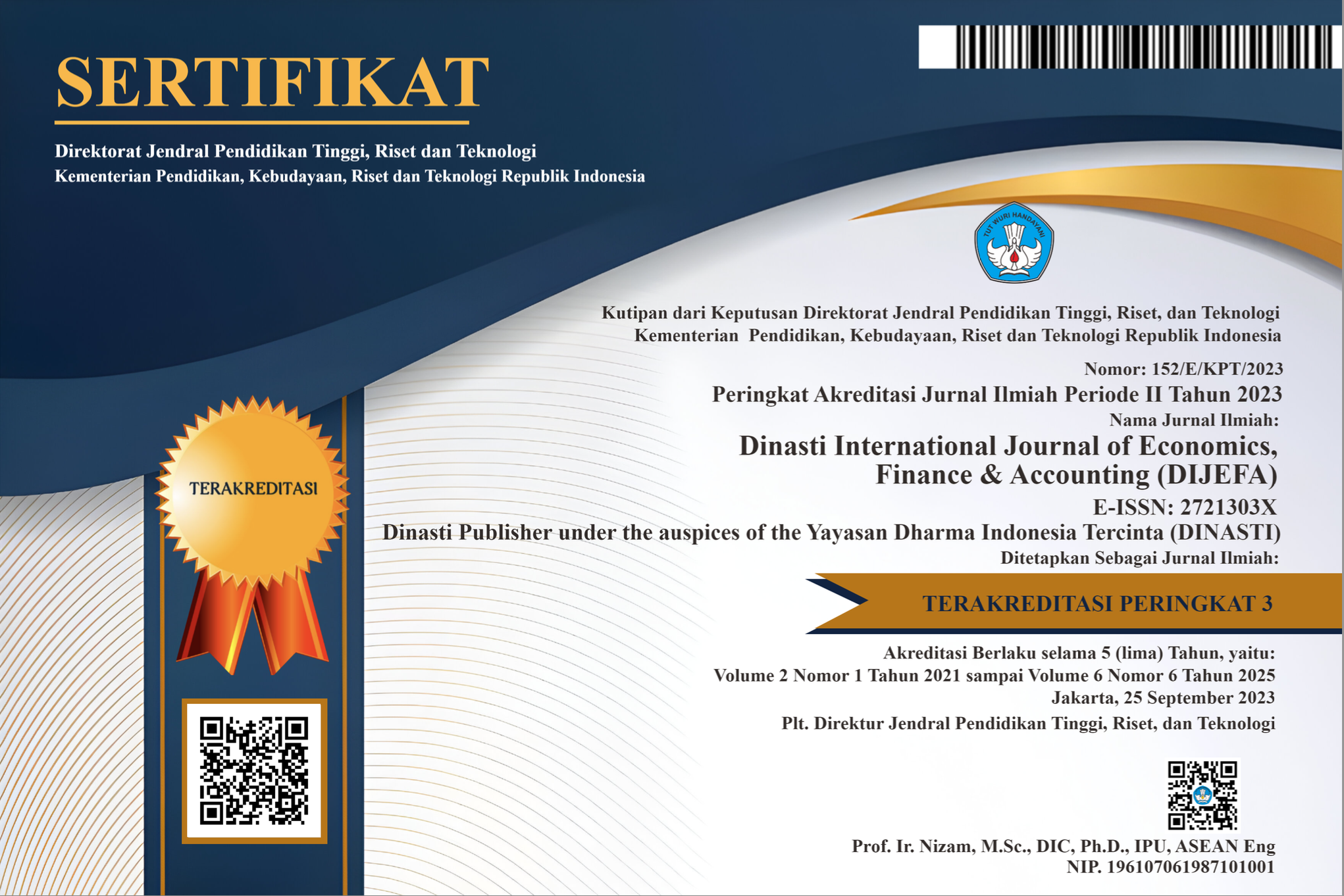Consumer Buying Behavior on Myntra: Analyzing Influencing Factors and Their Impact on Satisfaction
DOI:
https://doi.org/10.38035/dijefa.v5i5.3887Keywords:
Consumer Behavior, Myntra, e-Commerce, Customer Satisfaction, Online ShoppingAbstract
This research explores consumer buying behavior on Myntra, a leading online fashion platform in India, focusing on factors influencing purchasing decisions and their impact on customer satisfaction. A survey of 100 Myntra users in Ahmedabad was conducted, utilizing a quantitative approach and stratified random sampling. The study identified key factors such as pricing, product variety, promotions, and user experience, and evaluated their role in shaping consumer behavior. The findings suggest that demographic variables (age, gender, and occupation) have minimal influence on shopping behavior, while satisfaction and purchase decision-making were influenced by factors like pricing strategies and personalized recommendations. The study provides insights into Myntra's market positioning and offers recommendations for improving customer engagement.
References
Anwar, M. M. (2024). How does TAM affect impulsive buying on halal fashion products via shopping mobile apps? Journal of Islamic Marketing, ahead-of-print(ahead-of-print). https://doi.org/10.1108/JIMA-03-2023-0096
Arya, K., & Chauhan, R. (2024). Consumers in the pandemic: Contented or discontented. In N. Singh, P. Kansra, & S. L. Gupta (Eds.), Navigating the digital landscape (pp. 181-216). Emerald Publishing Limited. https://doi.org/10.1108/978-1-83549-272-720241011
Badewi, A. A., Eid, R., & Laker, B. (2023). Determinations of system justification versus psychological reactance consumer behaviours in online taboo markets. Information Technology & People, 36(1), 332-361. https://doi.org/10.1108/ITP-12-2018-0555
Ben Saad, S., & Choura, F. (2023). Towards better interaction between salespeople and consumers: The role of virtual recommendation agent. European Journal of Marketing, 57(3), 858-903. https://doi.org/10.1108/EJM-11-2021-0892
Chetioui, Y., & El Bouzidi, L. (2023). An investigation of the nexus between online impulsive buying and cognitive dissonance among Gen Z shoppers: Are female shoppers different? Young Consumers, 24(4), 406-426. https://doi.org/10.1108/YC-06-2022-1548
Chung, N., Song, H. G., & Lee, H. (2017). Consumers’ impulsive buying behavior of restaurant products in social commerce. International Journal of Contemporary Hospitality Management, 29(2), 709-731. https://doi.org/10.1108/IJCHM-10-2015-0608
Davis, F., Francis Gnanasekar, M. B., & Parayitam, S. (2021). Trust and product as moderators in online shopping behavior: Evidence from India. South Asian Journal of Marketing, 2(1), 28-50. https://doi.org/10.1108/SAJM-02-2021-0017
Dawson, S., & Kim, M. (2009). External and internal trigger cues of impulse buying online. Direct Marketing: An International Journal, 3(1), 20-34. https://doi.org/10.1108/17505930910945714
Ek Styvén , M., Foster, T., & Wallström, Å. (2017). Impulse buying tendencies among online shoppers in Sweden. Journal of Research in Interactive Marketing, 11(4), 416-431. https://doi.org/10.1108/JRIM-05-2016-0054
Goldsmith, R. E., & Flynn, L. R. (2005). Bricks, clicks, and pix: Apparel buyers' use of stores, internet, and catalogs compared. International Journal of Retail & Distribution Management, 33(4), 271-283. https://doi.org/10.1108/09590550510593202
Goldsmith, R. E., & Goldsmith, E. B. (2002). Buying apparel over the Internet. Journal of Product & Brand Management, 11(2), 89-102. https://doi.org/10.1108/10610420210423464
Hansen, T. (2005). Consumer adoption of online grocery buying: A discriminant analysis. International Journal of Retail & Distribution Management, 33(2), 101-121. https://doi.org/10.1108/09590550510581449
Jain, S. (2024). Factors influencing online luxury purchase intentions: The moderating role of bandwagon luxury consumption behaviour. South Asian Journal of Business Studies, 13(1), 90-117. https://doi.org/10.1108/SAJBS-09-2021-0352
Kathuria, A., & Bakshi, A. (2024). Influence of website quality on online impulse buying behaviour: A systematic review of literature. Marketing Intelligence & Planning, 42(5), 816-849. https://doi.org/10.1108/MIP-05-2023-0241
Lavuri, R. (2023). Intrinsic factors affecting online impulsive shopping during the COVID-19 in emerging markets. International Journal of Emerging Markets, 18(4), 958-977. https://doi.org/10.1108/IJOEM-12-2020-1530
Li, L., Kang, K., Zhao, A., & Feng, Y. (2023). The impact of social presence and facilitation factors on online consumers' impulse buying in live shopping – Celebrity endorsement as a moderating factor. Information Technology & People, 36(6), 2611-2631. https://doi.org/10.1108/ITP-03-2021-0203
Lin, S.-C., Tseng, H.-T., Shirazi, F., Hajli, N., & Tsai, P.-T. (2023). Exploring factors influencing impulse buying in live streaming shopping: A stimulus-organism-response (SOR) perspective. Asia Pacific Journal of Marketing and Logistics, 35(6), 1383-1403. https://doi.org/10.1108/APJML-12-2021-0903.
Liu, Y., Li, Q., Edu, T., Jozsa, L., & Negricea, I. C. (2020). Mobile shopping platform characteristics as consumer behavior determinants. Asia Pacific Journal of Marketing and Logistics, 32(7), 1565-1587. https://doi.org/10.1108/APJML-05-2019-0308
Ozen, H., & Engizek, N. (2014). Shopping online without thinking: Being emotional or rational? Asia Pacific Journal of Marketing and Logistics, 26(1), 78-93. https://doi.org/10.1108/APJML-06-2013-0066
Rahman, M. F., & Hossain, M. S. (2023). The impact of website quality on online compulsive buying behavior: Evidence from online shopping organizations. South Asian Journal of Marketing, 4(1), 1-16. https://doi.org/10.1108/SAJM-03-2021-0038
Rana, S. M. S., Azim, S. M. F., Arif, A. R. K., Sohel, M. S. I., & Priya, F. N. (2024). Investigating online shopping behaviour of generation Z: An application of theory of consumption values. Journal of Contemporary Marketing Science, 7(1), 17-37. https://doi.org/10.1108/JCMARS-03-2023-0005
Sahney, S., Ghosh, K., & Shrivastava, A. (2014). Buyer’s motivation for online buying: An empirical case of railway e-ticketing in Indian context. Journal of Asia Business Studies, 8(1), 43-64. https://doi.org/10.1108/JABS-07-2011-0036
Singh, R., Sihag, P., & Dhoopar, A. (2023). Role of resilient leadership and psychological capital in employee engagement with special reference to COVID-19. International Journal of Organizational Analysis, 31(1), 232-252. https://doi.org/10.1108/IJOA-09-2021-2975
Source, P., Perotti, V., & Widrick, S. (2005). Attitude and age differences in online buying. International Journal of Retail & Distribution Management, 33(2), 122-132. https://doi.org/10.1108/09590550510581458
Sumi, R. S., & Ahmed, M. (2022). Investigating young consumers’ online buying behavior in COVID-19 pandemic: Perspective of Bangladesh. IIM Ranchi Journal of Management Studies, 1(2), 108-123. https://doi.org/10.1108/IRJMS-09-2021-0127
Urumsah, D. (2015). Factors influencing consumers to use e-services in Indonesian airline companies. In E-services Adoption: Processes by Firms in Developing Nations (Advances in Business Marketing and Purchasing, Vol. 23B, pp. 5-254). Emerald Group Publishing Limited. https://doi.org/10.1108/S1069-09642015000023B002
Venkatesh, V., Speier-Pero, C., & Schuetz, S. (2022). Why do people shop online? A comprehensive framework of consumers’ online shopping intentions and behaviors. Information Technology & People, 35(5).
Downloads
Published
How to Cite
Issue
Section
License
Copyright (c) 2024 Om Jadhwani, Tiya Mohnia, Pranjal Suda, Rahul Chauhan, Andino Maseleno

This work is licensed under a Creative Commons Attribution 4.0 International License.
Authors who publish their manuscripts in this journal agree to the following conditions:
- The copyright on each article belongs to the author(s).
- The author acknowledges that the Dinasti International Journal of Economics, Finance & Accounting (DIJEFA) has the right to be the first to publish with a Creative Commons Attribution 4.0 International license (Attribution 4.0 International (CC BY 4.0).
- Authors can submit articles separately, arrange for the non-exclusive distribution of manuscripts that have been published in this journal into other versions (e.g., sent to the author's institutional repository, publication into books, etc.), by acknowledging that the manuscript has been published for the first time in the Dinasti International Journal of Economics, Finance & Accounting (DIJEFA).


























































